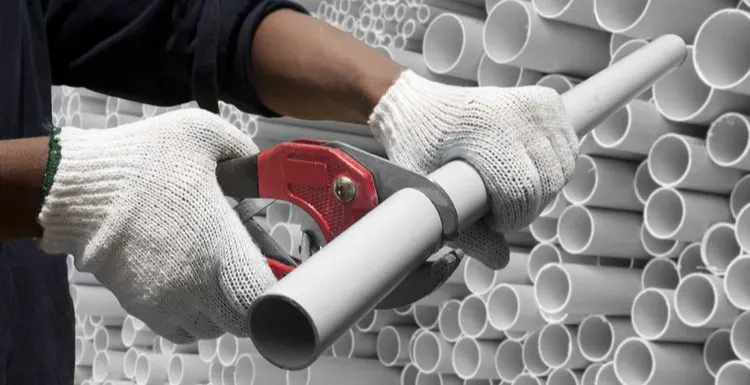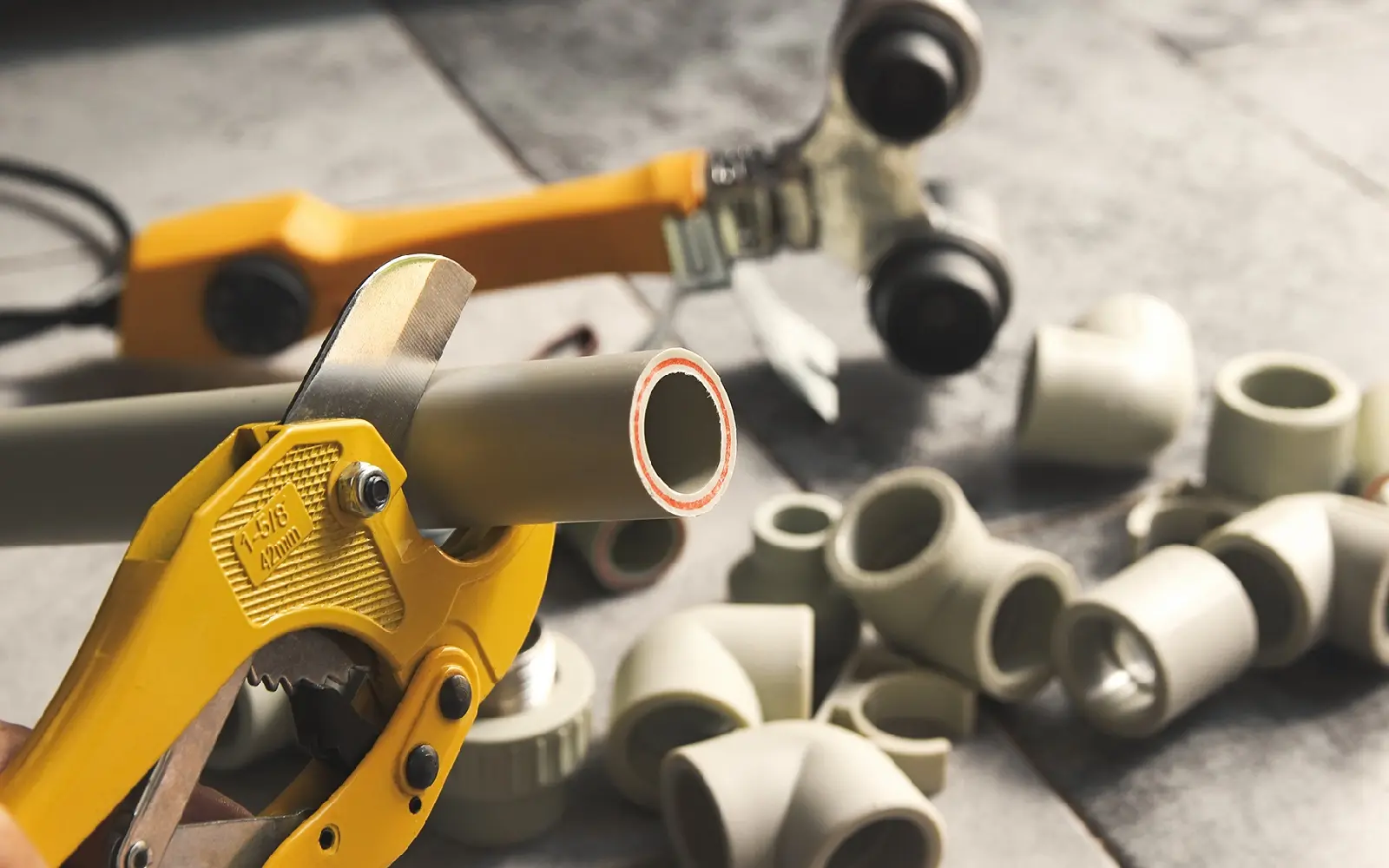You aren’t a repairman, right? So, why should you learn how to cut PVC?
Some people ask this question. However, it’s a handy skill that might prove useful one day.
Read on to learn all you need to know about cutting PVC.
How to Cut PVC in 6 Easy Steps
Having the ability and knowledge to cut PVC is a useful skill. Many repairs require that you properly fit PVC, and learning how to take care of this step on your own can save you big bucks down the road.
By learning how to lubricate your PVC, investing in the proper safety gear and tools, and learning how to use and store those tools, you’ll be well on your way to cutting your own pipes.
You can cut it with a hand saw, a miter saw, or a PVC cutter. However, if you don’t know how to cut PVC correctly, you’ll find it frustrating.
Cutting PVC is pretty easy—even easier than cutting other building materials. It can be cut in different ways and shapes, depending on the tools you have access to.
Here’s a step-by-step guide on how to cut PVC. Preparation is key to cutting a PVC pipe the right way, so follow this as closely as possible.
Step 1. Lubrication

Devil23/Shutterstock
The first step to cutting a PVC pipe is lubrication. It makes the process quicker and more comfortable. When you cut a PVC pipe, you’ll experience a lot of friction in the process.
Friction is normal, but to you, it’s frustrating. A lubricant will help reduce friction and improve the blade’s efficiency.
Another purpose the lubricant serves is to reduce the pollution caused by the pipe’s particles. However, if you use too much oil, the process will be messy, and the purpose will be defeated.
You also need some sort of pivot to hold the pipe in place. Even an experienced hand still needs a pivot to hold down the pipe.
As you cut, you want to be careful not to cut yourself or injure another person. You have to be vigilant while cutting your PVC.
Step 2. Wear Safety Gear

NIKCOA/Shutterstock
You should always wear safety goggles and gloves while cutting the pipe. After all, it’s dangerous. When you cut, there’s a probability that shards of the pipe will fly around, and some of them can enter your eyes.
Try to wear a face mask to protect your lungs and nose from the pipe’s particles. Though the particles aren’t typically considered hazardous to your health if inhaled and are non-toxic, they can still cause coughing and discomfort.
The goggles will protect your eyes from anything entering, obstructing, and limiting your vision while using dangerous objects, while the gloves will protect your hands from cuts or scrapes. Remember, your health is far more important than the pipe.
Step 3. Sharpen Your Blade

kkssr/Shutterstock
Never use a dull blade to cut your pipe. A sharp blade will cut straight and true without causing trouble. A dull blade will give you problems and, in some cases, hurt you.
You should also make sure that the blade isn’t loose before you cut. A loose blade will not cut the pipe straight. Instead, it will cut it badly and can cut you if you aren’t careful.
While you can use nearly any type of saw to cut your own PVC pipe, many people prefer to use a hacksaw. Hacksaws offer more control and flexibility over your cuts, making the process more precise and easier to manage.
The downside of using a hacksaw is that it can easily drift if you don’t control it properly, leading to uneven cuts or, even worse, injuries.
It will also leave your PVC pipe with burred edges, which may not look as clean-cut as if you were to use a miter saw.
This tends to not be too much of a problem, considering PVC pipe is often hidden under cabinets or behind walls. You can also easily knock off the excess PVC, or burred edges, with a butter knife.
Step 4. Point the Blade Away While Cutting

Toa55/Shutterstock
Let the blade point away from you. If any mistake occurs, the saw should fly away from you and not towards you. Always make sure to be mindful of where your hand is during the cutting process.
You don’t want your hand so close to the blade that one slip could cause a major accident, but you also want it close enough to maintain control.
Always be aware of your hand placement. And always, always take your hands away from places that are close to the blade. You should never use your hand as a vice or hold a pivot while cutting the PVC pipe.
Step 5. Read the Instructions Manual Carefully

Hans Geel/Shutterstock
Always read the instruction manual for every piece of equipment you want to use. This is the number one safety rule for machines. An instruction manual contains the working processes of the equipment.
It also shows what you should do and what not to do. Reading this manual and following it is the first step to securing your safety. Note that the instructions for different methods will vary.
Some tiny differences might be what determine whether you get an exquisite finish or end up with a messy job. Below are a few specifics:
- When cutting with the rotating pipe cutter, place the point you want to cut on the blade. The blade is located in the jaws of the cutter. After setting it well, you should squeeze the cutter’s handles together and rotate it around the pipe.
- For the ratcheting pipe cutter, with the blade in the marked spot, squeeze until you reach the pipe wall. Release the pipe cutter, re-squeeze, and repeat the procedure until the cutter is through the pipe.
- To use a hand saw, you have to hold it over a pivot to keep it in place. Mark the spot you want to cut, hold your hand over the pivot and the pipe, and begin to saw through the pipe.
- When using a miter saw, clamp the PVC pipe to the saw base and set the blade to the spot you want to cut. Make sure your hand is straight and accurate. Drop the blade on the spot and saw slowly through the pipe, then turn off the saw button to stop the blade before lifting it back up.
Step 6. Store Your Equipment Properly
Make sure to keep your equipment in a safe place after its use. If you don’t do this, an unsuspecting person might get hurt. Sometimes, it could be you.
Things to Consider

Surachet Jo/Shutterstock
Before cutting your own PVC, there are several things you’ll want to consider to keep you and your PVC in top shape:
Things to Do
- Lubricate your PVC before cutting
- Sharpen your blade
- Keep hands away from blade
- Wear safety goggles, gloves, and masks
Things Not to Do
- Point blade towards you when cutting
- Skip reading the user’s manual of your equipment
- Use a loose blade
- Improperly store your equipment after use
So, How Do You Cut PVC?
Anyone can learn how to cut PVC; all it requires is a bit of dedicated practice.
Remember, safety is your utmost priority, and you have to be careful when dealing with tools, especially a miter saw.
Follow the steps closely, and you’ll be cutting PVC like a pro in no time!

